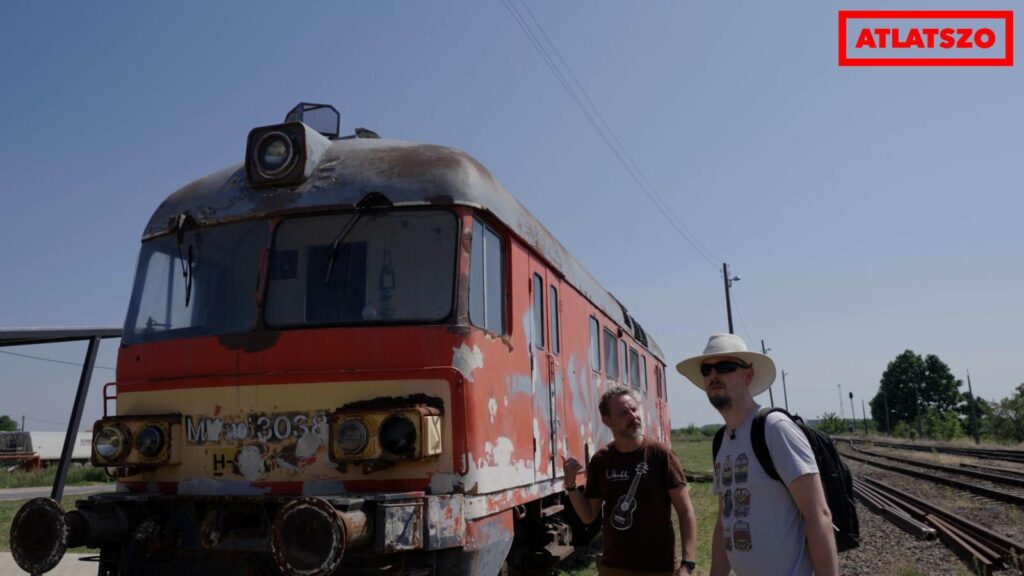The https://english.atlatszo.hu use cookies to track and profile customers such as action tags and pixel tracking on our website to assist our marketing. On our website we use technical, analytical, marketing and preference cookies. These are necessary for our site to work properly and to give us inforamation about how our site is used. See Cookies Policy
Busy passenger rail line closed for the benefit of Chinese battery factory
The railway between Debrecen and Nagykereki was one of the busiest branch lines in Hungary. However, the interests of a Chinese corporation took precedence over those of the South-East Hungary residents. The 106 railway goes through land that has been gifted to the company CATL to support a battery factory. As the project began, the Ministry of Transportation ordered the line’s closure. Átlátszó documented the last day of the doomed railway.
October 18, 2025, 8:25 p.m., Pocsaj-Esztár railway station. A man in uniform stands with his family, his wife and children, for a final photo in front of a Russian-made motor train running on line 106 on the platform. But it’s not just the railway workers who have come to take a last photo. On the platform, railway enthusiasts, trainspotters with professional cameras, and locals with cell phones are looking for the best angle for each picture. This is not about railway enthusiasm, it is about making memories. Memories of a railway line that people loved and used, but which the government closed because it was in the way of the Chinese CATL battery factory. That day’s evening’s service was the last train to carry passengers from Nagykerek to Debrecen on line 106.

As Átlátszó reported earlier, the 106 railway goes through land that has since became part of the planned expansion of the CATL battery factory in Debrecen. The company requires the use of the rails for their own logistics, at least according to public officials. Even though the battery factory’s expansion is not yet a done deal – reports suggest that the project has been postponed indefinitely due to Trump’s trade war – the elimination of line 106 has already been decided by the Ministry of Transportation.
Documents previously published by local media show that in 2024, Minister János Lázár had already ordered an impact study to be prepared on the service consequences of replacing line 106.
Officials avoiding the truth
Both the Ministry and the local government of Debrecen, as well as the national railway company MÁV attempted to explain away why the lane’s closure was necessary. In December 2024, according to the minutes of the county assembly meeting, József Pántya, Deputy State Secretary of the Ministry claimed that
“unfortunately, the 106 line is not in good condition, but it does carry traffic. Changes are expected here, and the issue of replacing trains on the railway line with buses is definitely on the agenda.”
“Carries traffic” was an understatement: the 106 was Hungary’s second busiest branch line, with 350,000 passengers a year, and more than a thousand passengers on most days. It was also a highly praised pilot project that demonstrated the potential for developing branch lines. The Indóház Online transport magazine followed the fate of line 106 with particular attention. This is how they wrote about how they managed to increase passenger numbers by one and a half times in a short period of time:
“The 2010s heralded a new golden age for the 106 line. With the cooperation of thirteen municipalities along the line, a number of minor infrastructure developments were carried out as part of an EU-funded project entitled “From the River to the Sea – Development of Complex Community Transport in Bihar”: several stations and stops were renovated with high platforms, regular timetables were introduced, and the public was served by modern, partly low-floor railcars and feeder bus services. (…) A total of 14 railway platforms were rebuilt, passenger information was improved at six locations, and station buildings and bus stops were renovated at a cost of no less than HUF 526 million, of which HUF 499 million was provided by the European Union.”
It is true that the renovation of the track (carried out by MÁV) was not without problems. The most critical sections were neglected, while sections in relatively good condition were renovated. All this could have been prevented by a smarter allocation of the funds earmarked for track renovation, or by a complete renovation.
On the day of the line’s closure, MÁV claimed that the “temporary bus replacement service” will shorten the journey by half an hour, which will actually benefit passengers. However, the line that could serve the region more cheaply and efficiently is actually replaced by five bus lanes. Among these there is only one that is faster than the train – because it goes on a highway, bypassing one of the former train stops.
In the announcement, MÁV used the term “temporary replacement” to avoid using the term “discontinuation”,
and referenced a “relocation” of the route. To quote:
“It is important to emphasize that railway line 106 will not be discontinued, but will be given a new route that is more suitable for job-creating investments in the region. Thus, after the demolition of the affected section of track and the preparation and construction of the new route, train traffic will return here – according to the MÁV Group’s intentions, with a better timetable and overall service level than before.”
Promises unlikely to be fulfilled
At the same time the Debrecen local government also began to communicate that the line would not actually be closed down, but modernized – omitting the fact that the land where the rails run through was given over to CATL.
“The new high-speed railway line No. 104 will be built between Debrecen and Berettyóújfalu, while line No. 106 will remain in parallel with it in a modernized form for regional, suburban, and local traffic” – the city’s statement read.
In reality, there are no plans to build line 104 or relocate line 106.
The Ministry of Transportation only issued a conditional tender for the design of a completely new railway line between Debrecen and Berettyóújfalu in May this year. In other words, the design of the line has not even begun. From this point to implementation, even with strong determination and in the most ideal case, it will take roughly a decade and a half, or approximately 15 years.
The 106, the Debrecen–Nagykereki line, could be put in the shop window as an example of what happens when a branch line gets proper attention. Although only the section that was in better condition to begin with—as far as Derecske—was refurbished recently (that alone would be worth a few words), thanks to lobbying by the mayors, model stations were renovated, shared bus–train platforms were built, and, generally, thanks to care and attention, passenger numbers surged.
It is not even clear if a completely new line would return the investment it needed. The 106, rebuilt and renovated to its original length, could easily serve the route between Debrecen and Oradea, Romania with a journey time of just over an hour, and would be much better utilized. Let’s ask the question: where would most people travel to Oradea from? From Debrecen, or from the border towns that are closer to Oradea than Debrecen? According to the plans for both lines, they would have to go to Debrecen and change to the express train at Sáránd.
Similarly, the cost of building the new line seems low compared to the possibility of traveling from Budapest to Cluj-Napoca via Debrecen. Trains from the capital to Debrecen and Cluj-Napoca run on the same line to Püspökladány. The distance between Püspökladány and Berettyóújfalu is 33 km on an almost straight line. However, traveling from Püspökladány to Debrecen and then turning back at an acute angle towards Berettyóújfalu on the planned new line would be 82 km. No one has ever spent so much money on something that is worse.
CATL the only winner
There is another possibility. According to this, as part of its agreement with CATL, the Hungarian government did not simply undertake to hand over the land and the tracks, but to build the container terminal, an industrial railway, and even the Debrecen-Berettyóújfalu railway line, which is suitable for speeds of up to 160 km/h, for the Chinese investor.
In a summary of public road developments in Hajdú-Bihar County published by local outlet Debreciner, it appears that a high-speed railway connecting Debrecen and Berettyóújfalu was in the plans as early as 2024. This would connect to an industrial railway serving the battery factory’s transport needs, leaving the CATL area to the south. The plans also show that the associated freight terminal would be built on the land to be transferred to the Chinese investor, so it is clear that
all changes affecting line 106 are due to CATL’s need for the land crossed by the current route.
It is not yet clear whether the line 106 will never actually reopen, or that a new line will indeed be built for CATL. Two things are certain: that both scenarios are scandalous, and that on the evening of October 18, 2025, the last train left Debrecen on the track that stood in the way of CATL’s expansion towards Nagykereki.

